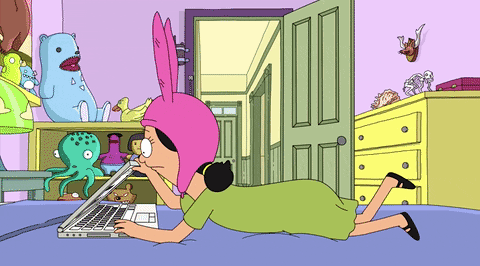This review originally appeared in the September 19, 2019 issue of The Content Technologist with the email subject line "A glutton for internet culture" and a review of conversation research tool MediaCloud.
Gifs have changed conversation and online communication. They’re punctuation marks. They indicate how we should feel after consuming something. They signal how the author feels. Like having an in-person conversation with someone, gifs are empathy machines. And Giphy has become the one search engine to rule them all.
Founded in 2013, Giphy is the leading gif search engine with about 250 million daily active users. Google more or less redirects every single search phrase with a “gif” modifier to the most relevant page on Giphy. Before Giphy, we collected gifs via gif-o-pedia blog posts or tumblrs that collected the gifs of our collective emotions. Those blog posts and tumblrs are all broken now, so long live Giphy.
Now we spend an absurd amount of time searching for the right gif. Whether it’s on Slack or in texts or in literally any other channel… our gif options are so numerous that finding the right one for the situation can be so entertaining… that it becomes a bit of a slog.
![Louise from Bob's Burgers typing on a laptop [gif]](https://cdn.substack.com/image/fetch/w_1100,c_limit,f_auto,q_auto:good/https%3A%2F%2Fbucketeer-e05bbc84-baa3-437e-9518-adb32be77984.s3.amazonaws.com%2Fpublic%2Fimages%2Febd1714f-133f-4072-931b-409be81eed2d_480x266.gif)
The empathy factor in gif optimization
Great gif usage is not about the actual content of the gif. Someone who is quite proficient at using gifs — btw I consider myself an intermediate user— understands that it’s 85% about how the user feels after watching the gif.
Placing a gif is an empathetic tactic. A gif signals that are sharing a feeling, all the while trying to understand your audience’s mindset — whether it’s your partner or someone you’ve just met.
Giphy’s brief tagging guidelines also mention the empathy factor:
Tags should also talk about how you react to the image, how you believe the subject is reacting in the image, and any other details you think are pertinent.
When you think of the best gifs, they’re not about the subject. They’re about the conversation.
![Ilana from Broad City widening her eyes and nodding [gif]](https://cdn.substack.com/image/fetch/w_1100,c_limit,f_auto,q_auto:good/https%3A%2F%2Fbucketeer-e05bbc84-baa3-437e-9518-adb32be77984.s3.amazonaws.com%2Fpublic%2Fimages%2Fb5db2d18-a0cf-4cfc-a9eb-47df48bde5cf_480x270.gif)
When you should consider gif optimization
Entertainment companies have it nailed: release a gifset with every new season of a tv show/movie and hopefully someone will glom on to those gifs. Of course, you can always tell the fan-made reaction gifs from the Official Promoted Gifset. The fan-made reaction gifs are better, more honest, less promotional! No matter how long you’ve been working in entertainment marketing, you can’t always figure out exactly how the internet will attach and replicate crucial emotional points in your text!
But I’m not speaking to entertainment companies here — I’m speaking with you, content enthusiast. We need more great gifs.
![Kids' show (Cbeebies BBC) footage where adults are dancing silly [gif]](https://cdn.substack.com/image/fetch/w_1100,c_limit,f_auto,q_auto:good/https%3A%2F%2Fbucketeer-e05bbc84-baa3-437e-9518-adb32be77984.s3.amazonaws.com%2Fpublic%2Fimages%2Fa7b3377e-89e2-44a5-bd46-f6f8d57e3a27_480x270.gif)
Let’s say there’s an event that you’re covering. A big event, something like the Minnesota State Fair, widely held by this informal poll to be the best damn state fair in the country. Let’s say that you’re sharing content about the state fair and you notice that, when you search on Giphy for “state fair” or “fair food,” you get a bunch of gifs from the Oklahoma and Wisconsin State Fairs. (Minnesota media! This is a huge opportunity to just put gifs on giphy and tag them State Fair and put a little watermark in the corner. I’m seriously disappointed by MN’s gif game and very impressed by Oklahoma’s.)
(Also I may or may not have been inspired by the search for finding fair gifs when I wrote this post.)
Optimizing for “State Fair” would be an easy win once a year. But I’d also recommend optimizing for conversational terms that fair gifs could evoke like “I’d eat that” or “get ready” or “long day.”
![Kate Hudson scarfs a burger in How to Lose a Guy in 10 Days [gif]](https://cdn.substack.com/image/fetch/w_1100,c_limit,f_auto,q_auto:good/https%3A%2F%2Fbucketeer-e05bbc84-baa3-437e-9518-adb32be77984.s3.amazonaws.com%2Fpublic%2Fimages%2Fd8180dce-0d0b-4853-af5e-2bc4047ff4f2_498x280.gif)
Can we recreate this classic romantic comedy scene with MN State Fair food?
I’d recommend that you create a gifset whenever you have great video content, or whenever you’re in a situation where reactions are outsized and it’s easy to capture fun. Seriously, it takes about five minutes to create and optimize a decent gif. (Make sure you have the gif subject’s permission of course.) You can make and upload a gif from your phone.
Gif optimization isn’t about driving traffic back to your website. But it is about sharing your goodness and empathy with the world. A few good gifs — whether they’re branded or just out there — can bring a whole bunch of joy.
Other gif optimization notes
I prefer reaction gifs without subtitled text, but that is a personal preference! Text + video clarifies for certain.
- Instructive gifs are honestly the best thing you can possibly to do to optimize a how-to article. They’re a great way to hone in on a specific craft or technique that you can watch over and over and over again.
- Gifs are massive files and the fact that we are able to use them regularly is amazing from a processing perspective. If you’re creating gifs or using them on your site: Compress, compress, compress. (If you do not know how to compress files, talk to your video editor or graphic designer.)
- Short gifs convey a message quickly! Long gifs are a long shot!
- If you want to use gifs on your own website — a branding or personal choice — you may want to peep these guidelines for maintaining SEO performance while using gifs.
- As with all content, please be aware of the social context and history of the images you are creating and sharing!
![Stay Woke [neon gif]](https://cdn.substack.com/image/fetch/w_1100,c_limit,f_auto,q_auto:good/https%3A%2F%2Fbucketeer-e05bbc84-baa3-437e-9518-adb32be77984.s3.amazonaws.com%2Fpublic%2Fimages%2Fee5d3bda-98d9-4a05-ac6d-d937529a5093_500x500.gif)
Why we need more gifs
Paris Hilton, the original gif star, is still giffing about the internet with a surprising frequency. But The Simple Life was 15+ years ago and well. Culture keeps changing! And Giphy seems to reward recency and interaction!
![Paris Hilton says, "That's hot." From The Simple Life. [gif]](https://cdn.substack.com/image/fetch/w_1100,c_limit,f_auto,q_auto:good/https%3A%2F%2Fbucketeer-e05bbc84-baa3-437e-9518-adb32be77984.s3.amazonaws.com%2Fpublic%2Fimages%2F318df5a6-3c96-448c-912d-072d06bfa57d_400x300.gif)
Hand-picked related content





